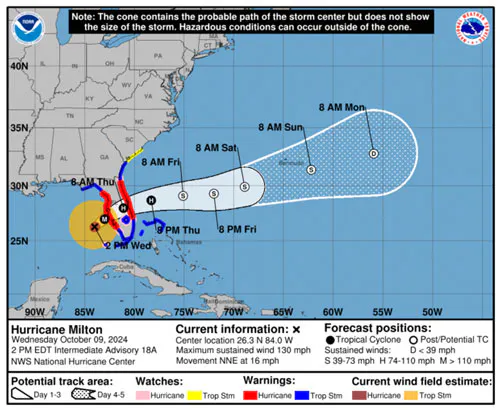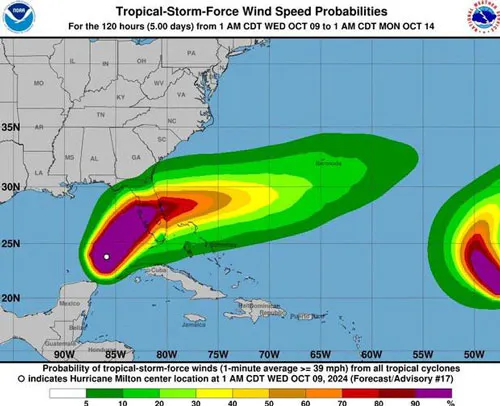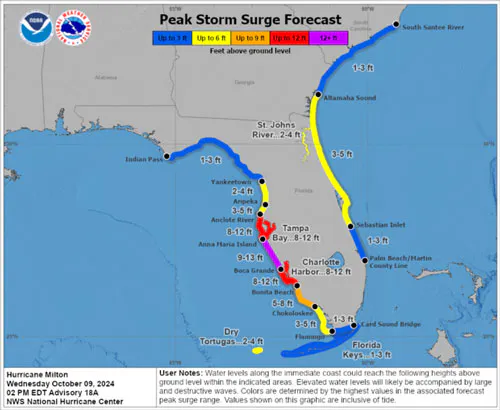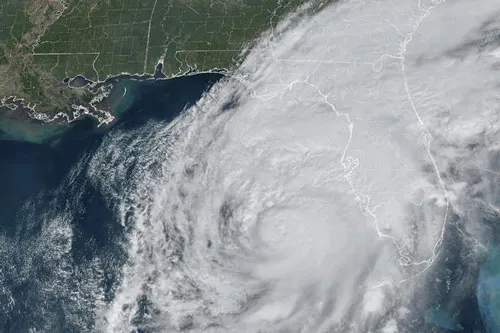Maps Show Track Of Hurricane Milton As It Makes Landfall In Florida
Hurricane Milton surged back up to a Category 5 then dropped down to Category 3 Wednesday, with forecasts showing it on a path to hit Florida's west-central Gulf Coast near Sarasota Wednesday night, the National Hurricane Center said.Wednesday, October 9th 2024, 8:04 pm
Hurricane Milton weakened slightly to a still-powerful Category 3 storm Wednesday as it made landfall along Florida's west-central Gulf Coast near Sarasota Wednesday night.
The storm made landfall at about 8:30 p.m. Eastern Time near Siesta Key in Sarasota County, the National Hurricane Center reported.
The hurricane center forecasted that it would then move across the central part of the Florida peninsula overnight, and emerge off the east coast of Florida on Thursday."
"This is an extremely life-threatening situation," the hurricane center warned earlier.
CLICK HERE for live updates on Hurricane Milton's Progress Toward Florida
 Image Provided By: CBS News
Image Provided By: CBS News
CBS News Meteorologist Nikki Nolan said Milton would continue across Florida while rapidly weakening after losing the fuel of the warm Gulf waters, but still maintaining its hurricane status as it exits into the Atlantic Ocean before quickly transitioning into a tropical storm Thursday afternoon.
Milton reached Category 5 strength Monday with sustained wind speeds as high as 180 mph, in a rapid intensification the hurricane center called "remarkable." The storm later dipped back to Category 4 before restrengthening. The NHC said Tuesday that it's "forecast to retain major hurricane status and expand in size" as it approaches Florida, calling the storm "catastrophic."
"While fluctuations in intensity are expected, Milton is forecast to remain an extremely dangerous hurricane through landfall in Florida," the hurricane center said.
Forecasters warned the storm would cause destructive and potentially life-threatening storm surge along a large stretch of the coastline in addition to "devastating" hurricane-force winds.
It is forecast to drench a large part of a state still reeling from Hurricane Helene.
Hurricane Milton live radar map
This radar loop from CBS Miami shows weather conditions over Florida and the Gulf of Mexico as Hurricane Milton approaches.

Path of Hurricane Milton
Maps from the National Hurricane Center show Milton bearing down on Florida's west coast as a major hurricane. The storm was traveling over the eastern Gulf of Mexico Wednesday ahead of landfall, driving strong winds and potentially some flooding along the west coast of Florida, which were expected to increase by the afternoon.
As of 2 p.m. ET Wednesday, Milton was centered about 130 miles west of Fort Myers, Florida, and about 150 miles southwest of Tampa. It was traveling north-northeastward at 16 mph with maximum sustained winds of 130 mph.
Tropical-storm-force winds were churning just offshore of the west coast of Florida as rain started to fall in Tampa Bay and an early storm surge rose in the southern peninsula, meteorologists said. Tornadic supercell storms gave way to a least a handful of tornadoes across a large section of the state, including southern and central areas, as final preparations ended and people hunkered down for Milton's landfall.
Florida Gov. Ron DeSantis had said Tuesday that the most recent models indicated the storm would make landfall somewhere in Manatee County, just south of Tampa Bay. The governor and the hurricane center both acknowledged Wednesday that predicting the exact landfall location even 12 hours ahead of time was challenging.
 Image Provided By: CBS News
Image Provided By: CBS News
A hurricane warning was in effect Tuesday for the Florida west coast from Bonita Beach north to Suwannee River, including Tampa Bay — as well the state's east coast from the St. Lucie-Martin County line north to Ponte Vedra Beach.
A storm surge warning was in place for Florida's west coast from Flamingo north to Suwannee River, including Charlotte Harbor and Tampa Bay. The hurricane center warned Tuesday that storm surge in the Tampa Bay area could reach 10 to 15 feet above ground level, but that prediction shifted overnight as Milton's projected path turned a bit southward.
Forecasters said Wednesday that storm surges could reach 8 to 12 feet in around Tampa Bay — still a potentially catastrophic outcome — and 9 to 13 feet from Anna Maria Island southward to Boca Grande. The latter area covers almost 75 miles of coastline and includes Sarasota.
 Image Provided By: NOAA/National Hurricane Center
Image Provided By: NOAA/National Hurricane Center
A storm surge warning was also in place on a stretch of the East Coast, from Sebastian Inlet, Florida, north to Altamaha Sound, Georgia, and several tropical storm watches warnings were also in effect for Florida, Georgia and South Carolina, along with Mexico and the Bahamas.
The National Hurricane Center warned of heavy rainfall of up to 18 inches across central and northern parts of the Florida Peninsula through Thursday, which could generate "catastrophic and life-threatening flash and urban flooding, along with moderate to major river flooding."
Nolan said the heaviest rainfall was expected along Florida's Interstate-4, with anywhere from 6 to 12 inches of rain, and up to 18 inches in some spots.
Florida officials prepare for more impact
DeSantis urged residents Wednesday morning to seek shelter at local- or state-run centers if they hadn't already evacuated to another place, warning that "there will be fatalities" linked to the storm because some people will decide not to follow evacuation orders. His latest comments echoed earlier ones Tuesday.
"You should be executing your plan now," DeSantis said in a briefing Tuesday afternoon. "If you're going to get out, get out now. You have time today, time will be running out very shortly if you wait any longer. Of course, there's a lot of mandatory evacs that have been done."
"I highly encourage you to evacuate" if you're in an evacuation zone, said Kevin Guthrie, executive director of the Florida Division of Emergency Management. "We are preparing ... for the largest evacuation that we have seen, most likely since 2017, Hurricane Irma. "
"We're prepared for another horrible hurricane to hit Florida," President Biden, who has postponed a trip to Germany and Angola because of Milton, told reporters during a visit to Milwaukee Tuesday. "I've directed my team to do everything they can to save lives, help communities before, during and after this hurricane."
He advised Floridians to "follow safety instructions, including evacuation orders. You got to be safe because people are dying. People have died so far, not from this hurricane, but from the last one."
 Image Provided By: NOAA VIA AP
Image Provided By: NOAA VIA AP
More Like This
October 9th, 2024
April 28th, 2025
April 28th, 2025
April 28th, 2025
Top Headlines
April 28th, 2025









